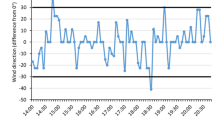Abstract
The Agricultural Reentry Task Force (ARTF) conducted a study to determine if dislodgeable foliar residues (DFR) are either normally or lognormally distributed. This is important because the data are used with worker exposure data, which generally appear to be lognormally distributed, to calculate transfer coefficients that will be used to assess farm worker re-entry exposure. Two chemicals were used for this study. Carbaryl, a moderately water-soluble chemical, was applied to cabbage at a rate of 2.0 lbs active ingredient/acre (lb ai/A), while methomyl, a highly water soluble chemical, was applied to cabbage at a rate of 0.9 lb ai/A. The residues were dislodged following an ARTF standardized procedure of collecting leaf punches and shaking in a solution of 0.01% Aerosol OT 75. A total of 28 samples were analyzed for each chemical. The mean±SD residue of the carbaryl samples was higher than that for methomyl (511±196 and 170±71 μg per sample, respectively). However, several types of statistical analyses of the data indicated that, for both chemicals, the residues are lognormally distributed.
This is a preview of subscription content, access via your institution
Access options
Subscribe to this journal
Receive 6 print issues and online access
$259.00 per year
only $43.17 per issue
Buy this article
- Purchase on Springer Link
- Instant access to full article PDF
Prices may be subject to local taxes which are calculated during checkout


Similar content being viewed by others
Abbreviations
- ARTF:
-
Agricultural Reentry Task Force
- DFR:
-
dislodgeable foliar residue
- TC:
-
transfer coefficient
References
Johnson D., Day E., Selman F., Klonne D., Bruce E., Eberhart D., Korpalski S., and Clark J. Agricultural Reentry Task Force: approaches for determination of worker exposure and dislodgeable foliar residues for agricultural reentry studies. Submitted for publication.
Johnson N.L., Kotz S., and Balakrishnan N. Continuous Univariate Distributions, Vol. 1. Wiley, New York, 1994.
SAS. SAS/STAT® User's Guide, Version 8, Vol. 1–3. SAS Institute Inc., Cary, NC, 1999.
SAS. SAS OnlineDoc® HTML Format, Version 8. SAS Institute Inc., Cary, NC, 2000.
Snedecor G.W., and Cochran W.G. Statistical Methods, 7th edn. Iowa State University Press, Ames, Iowa, 1980.
Tomlin C.D.S., (Ed.). The Pesticide Manual: A World Compendium, 11th edn. British Crop Protection Council, Farnham, Surrey, UK, 1997.
USEPA. Data Call-In Notice 18-Oct-1995, as amended 10-Jan-1997; copied to registrants of specific PC coded pesticide products, 1995.
Acknowledgements
The AFTF is deeply indebted to the many people who have served on both its administrative and technical committees of the ARTF over the last 7 years. Only through the dedication of such individuals, as well as the commitment of the member companies in allowing their employees to dedicate the time and effort required for such a massive, long-term project, could it have been successfully completed. The product of their labors will be a cornerstone of agricultural re-entry risk assessments for decades to come.
Author information
Authors and Affiliations
Additional information
Address all correspondence to: Dr. D. Johnson, Stewart Agricultural Research Services, Inc., 1893 Highway K, Clarence, MO 63437, USA. Tel.: +01-660-762-4240; Fax: +01-660-762-4295; E-mail: davejohn@marktwain.net
Rights and permissions
About this article
Cite this article
Korpalski, S., Bruce, E., Holden, L. et al. Dislodgeable foliar residues are lognormally distributed for agricultural re-entry studies. J Expo Sci Environ Epidemiol 15, 160–163 (2005). https://doi.org/10.1038/sj.jea.7500383
Received:
Accepted:
Published:
Issue Date:
DOI: https://doi.org/10.1038/sj.jea.7500383
Keywords
This article is cited by
-
Transfer factor calculated using dermal exposure and dislodgeable foliar residue and exposure assessment for reentry worker after pesticide application in cucumber field
Applied Biological Chemistry (2023)
-
Community-based intervention to reduce pesticide exposure to farmworkers and potential take-home exposure to their families
Journal of Exposure Science & Environmental Epidemiology (2009)
-
Effect of Dislodging Techniques on Foliar Residue Determination for Agricultural Crops
Archives of Environmental Contamination and Toxicology (2006)



